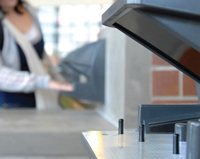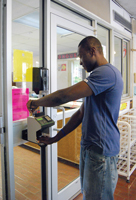
Unmistaken Identity
Hand readers ease heavy throughput for recreation center members
- By Jon Mooney
- Aug 03, 2009
 The University of Georgia has long been a pioneer in adopting biometrics, starting with a two-dimensional hand geometry device in 1972. When it was time to replace the school's old hand readers in 1990, the administration evaluated various biometrics technologies, such as facial, hand, fingerprint, iris and signature devices.
The University of Georgia has long been a pioneer in adopting biometrics, starting with a two-dimensional hand geometry device in 1972. When it was time to replace the school's old hand readers in 1990, the administration evaluated various biometrics technologies, such as facial, hand, fingerprint, iris and signature devices.
The university needed an access control system that was fast, easy to use and foolproof. To provide a safe and secure campus, the school wanted to verify students entering residence halls and athletic facilities and limit dining hall access to those who paid for a meal plan. Ingersoll Rand Security Technologies' Schlage HandKey hand reader was the answer. Today, there are 59 HandKey readers in service in the dining rooms, the Ramsey Recreation Center and all residence halls.
The hand geometry reader simultaneously analyzes more than 31,000 points and instantaneously records more than 90 separate measurements of a person's hand—including length, width, thickness and surface area—to verify the person's identification. The students use the keypad on the reader to enter their ID numbers and then place their hands on the hand reader. Verification takes about one second.
A Taste For Biometrics
Based on the HandKey readers' success in their food-service area, the university installed a similar system to control access to the Ramsey Recreation Center. More than 46,000 people on the center's membership list now use readers to enter the facility. At the Ramsey Center, two outdoor-style readers control the outer doors while standard hand readers inside the building control entry at the turnstiles.
"A biometric hand reader provides single-point entry, a true one-to-one match," said Bill McGee, manager of the Bulldog Bucks office, blackboard transaction system and UGA card services. "It calls for two types of verification: the person's ID number and their hand. Importantly, the units can be calibrated to adjust the sensitivity of the hand reads. We want ours to be very accurate, assuring only the right person can enter.
"Solely, the owner of the card bearing the ID number and the person himself/herself are authorized to enter our doors. With more than 8.5 million transactions per year, we're proving that that hand readers are durable."
"The primary reason that we brought in this device was convenience for students," said Carolyn McDaniel, assistant director of Student Affairs Business Operations at West Virginia University. "The students have said they don't want to bring their card: it is one more thing for them to keep track of. The rec center is probably the place where cards are most often lost."
The California Connection
Dr. Andrea Willer, director of Titan Recreation at California State University-Fullerton, agrees. Their system ties into the campus' card system, which automatically eliminates students who are no longer enrolled at the university.
"Visiting with our peers while touring their recreation center at San Diego State, we saw how our fellow  institution was deploying biometric hand readers to limit access only to those authorized," Willer said. "Being able to eliminate cards made a lot of sense to us. We wanted to be sure only those enrolled could get in, not those simply carrying somebody else's card."
institution was deploying biometric hand readers to limit access only to those authorized," Willer said. "Being able to eliminate cards made a lot of sense to us. We wanted to be sure only those enrolled could get in, not those simply carrying somebody else's card."
Today, there are eight hand readers used in the Titan Recreation Center. Three Schlage HandKey readers are placed at the turnstiles for accessing the center. Another three are used for enrollment into the system. The seventh reader is placed on the outside of the staff door so staff can enter the facility during off hours. The eighth device is a HandPunch reader that employees use to clock into and out of work.
"Although the university has a campus-wide card system, we've eliminated the need for cards for both access control and time-and-attendance recording," Willer said. "Students especially tend to forget their cards when coming to the center. Biometrics eliminates that worry for them and saves us time and money because we don't have to remedy such situations."
Across Orange County, at the University of California-Irvine, cards also were becoming burdensome.
"The No. 1 suggestion from our members was eliminating the need for ID cards," said Jill Schindele, director of campus recreation. "We took their suggestions seriously and feel that hand geometry is the fastest and most efficient alternative to identification cards. Campus Recreation is looking forward to the spring quarter, when members will have the convenience of enjoying access to the facility without the need for identification cards."
Likewise, down the freeway, San Diego State University's Associated Students has just celebrated 11 years of using 12 hand geometry readers to provide easy access into the six entrances at the Aztec Recreation Center, the Aztec Center bowling and games facility, and the racquetball court inside the center, as well as the four entrances to the Aztec Aquaplex.
The Aztec Recreation Center is made up of four multipurpose gyms, a cardio room, a weight training room, a fitness room, a 30-foot climbing wall, bowling alleys and racquetball courts; offers personal training and massage therapy; and houses intramural sports, sport clubs and recreational classes. The Aztec Aquaplex includes a 50- meter lap pool, recreation pool, hydrotherapy spa and aquatic equipment. Various activities, including water aerobics, are held there. Both can only be accessed by members, approximately 85 percent of whom are students. The rest are made up of faculty, staff and the community.
"The readers minimize people's ability to transfer IDs for admittance into our center," said Vicki Greene, member services coordinator for the Associated Students of SDSU. "ID switching is very big in the fitness club industry. The hand readers also allow us to provide better service. Now our members don't have to remember to bring an ID card. This also means we don't need to have an employee out front checking cards."
Upstate, the new recreation center at the California State University-Chico will be run by Innosoft's Fusion Recreation Management System. Like the other recreation centers, the building will be secured by turnstiles and hand geometry readers.
"The hand readers will work in harsh environments and provide higher security for our customers' recreational facilities and equipment rooms," said Jeff Berg, Innosoft product manager. "No longer can a member transfer his ID card to another for admittance to facilities to which they do not belong."
Beyond Member Verification
"We also can track who is in the building when," Willer said. "For instance, we once had a problem with some thefts in the locker rooms. Once we knew when the thefts happened, we could check on who was in the building during those times. From this, we could denote a pattern of the same people being in the facility each time the thefts occurred. We quickly narrowed down our list of suspects to stop the crimes.
"The HandKey readers also help us with risk management. To be a member of the recreation center, enrollees must sign a waiver and other legal documents. However, non-members were getting around this requirement by simply using a member's card, putting the university in a liability position. Today, only those that are supposed to be in the building get in."
The Titan recreation center employs 120 students. For time/attendance/payroll recording, they use their eighth hand reader to clock in and out of work. The unit works just like the HandKey reader, except its data is sent to the university's payroll software. Just as the HandKey reader doesn't allow an unauthorized person to enter the recreation center, the HandPunch stops buddy punching while eliminating the mistakes made with manual timekeeping.
Throughput Is Essential
During the first semester of the 2008-2009 school year, Willer said approximately 10,000 people were enrolled over a two-week period. At the start of the second semester, the university enrolled approximately 2,500 people per day for three days.
"Today, about 2,500 people go through the turnstiles each day," Willer said. "We can get large numbers of people through the doors quickly. We had an evacuation recently where we needed to move approximately 300 to 400 people out and into the facility. The hand readers were able to handle this high volume."
The numbers are high at all the schools. At the University of Georgia Ramsey Center alone, the hand readers process 2.8 million transactions per year. San Diego States' Aztec Recreation Center and the Aquaplex have 16,000 active enrollees averaging 4,000 entries per day.
With so many users, keeping nonmembers out is just part of the job. It also is important to let authorized members in. It would be counterproductive to have staff on-call to physically let members in because the biometrics could not produce a read.
That's why hand readers tend to dominate in high-use applications such as the recreation centers. Hand readers handle any population volume with ease and reliability. With dramatically lower false rejection rates and failure to enroll rates than fingerprint biometrics, their value grows as the number of users and transactions increases.
In small applications with fewer than 100 people, the inconvenience caused by the higher error rates of fingerprint readers is not a big deal. However, when more people create large numbers of transactions, such as the thousands of transactions experienced by these recreation centers, throughput becomes an important factor.
Going Beyond Throughput
When considering which biometric to use, Willer said they had to decide between the Schlage HandKey reader and the Schlage FingerKey reader, which scans fingerprints.
"For political reasons, we selected the hand reader," Willer said. "We just did not want to get into discussions over fingerprint technology. We're glad we did as the students accepted the hand readers without hesitation."
Schindele said hand geometry is different than fingerprinting, and the information is not connected to the campus system. Campus Recreation stores this information on a secure internal network.
"We feel that hand geometry is the least invasive of the biometric technologies and seems simple compared to the others," Greene said.
"It's fun to show off our systems," McGee said. "Two schools visited us last year and have since installed hand readers at their facilities. They were amazed at the technology, how inexpensive it is and how easy hand readers are to install and manage. For those already using proximity or magnetic stripe cards, it's a simple matter to put a hand reader on top of the card-based system."